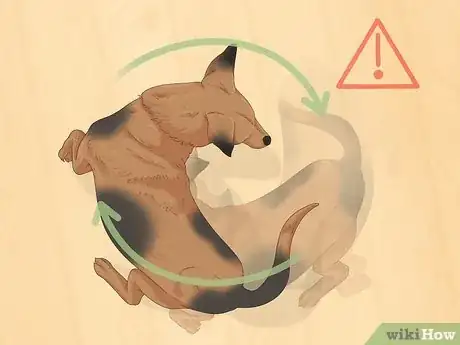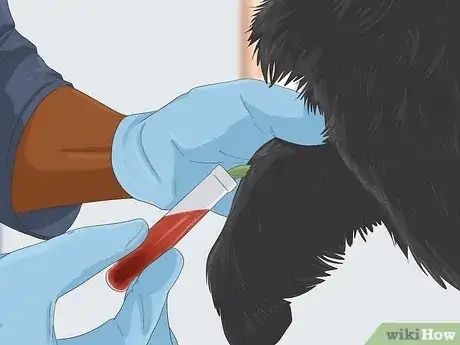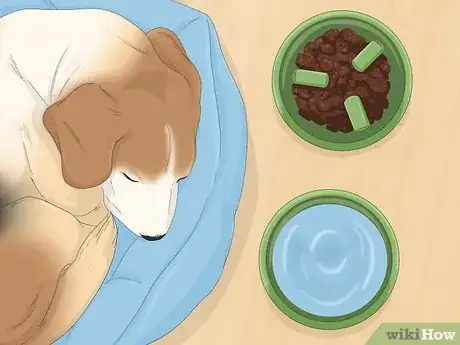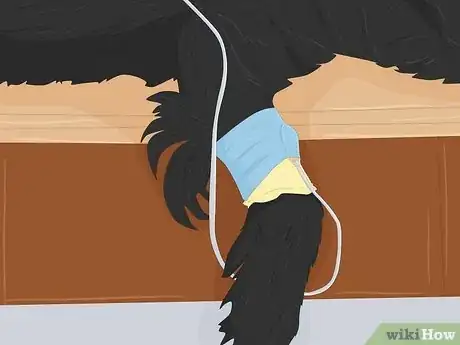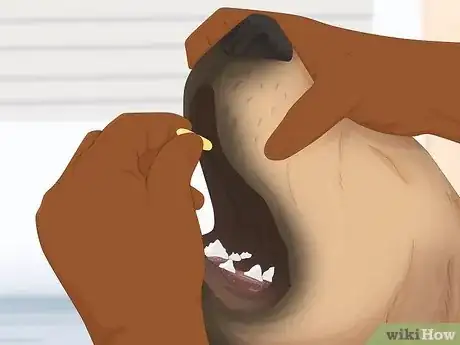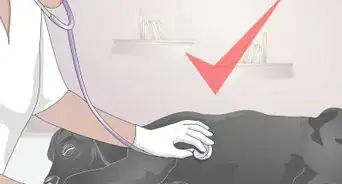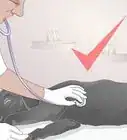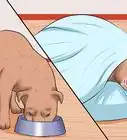This article was co-authored by Ray Spragley, DVM and by wikiHow staff writer, Amber Crain. Dr. Ray Spragley is a Doctor of Veterinary Medicine and the Owner/Founder of Zen Dog Veterinary Care PLLC in New York. With experience in multiple institutions and private practices, Dr. Spragley’s specializations and interests include non-surgical management of cranial cruciate ligament tears, Intervertebral Disk Disease(IVDD), and pain management in osteoarthritis. Dr. Spragley holds a BS in Biology from SUNY Albany and has a Doctor of Veterinary Medicine degree (DVM) from Ross University School of Veterinary Medicine. He is also a Certified Canine Rehabilitation Therapist (CCRT) through the Canine Rehab Institute as well as a Certified Veterinary Acupuncturist (CVA) through Chi University.
wikiHow marks an article as reader-approved once it receives enough positive feedback. In this case, 100% of readers who voted found the article helpful, earning it our reader-approved status.
This article has been viewed 106,856 times.
Witnessing your dog suffering with any type of illness or discomfort can be very unsettling for an owner. The signs of a canine stroke can be extremely frightening, although it is important to remember that this condition does not generally affect dogs as severely as it does humans. Learn to recognize the warning signs of canine stroke so that you can respond appropriately if this happens to your dog. If you think your dog has had a stroke, seek help from a vet right away and follow all treatment instructions carefully.
Steps
Recognizing Canine Stroke
-
1Look for the symptoms of canine stroke. Canine stroke typically occurs when blood vessels in the brain rupture (hemorrhagic stroke) or become blocked (ischemic stroke). The symptoms of canine stroke may appear quite suddenly, and may also be different from the typical signs of stroke in humans. Your dog may have had a stroke if it:
- Walks in circles for no apparent reason.
- Holds its head tilted to one side.
- Turns the wrong way when called.
- Has difficulty balancing, standing, or walking.
- Experiences extreme lethargy.
- Has sudden problems with bladder and bowel control.
- Shows signs of loss of vision.
- Suddenly collapses.
- You may also notice your dog’s eyes moving rapidly from side to side as if following a moving object (nystagmus). Stroke is only one possible cause of nystagmus, but it is always a good idea to get this symptom evaluated by a vet.
-
2Assess your dog’s risk factors for stroke. You can help your vet diagnose canine stroke and identify potential underlying causes more quickly by letting them know if your dog has any common risk factors for stroke. Stroke may be more likely to occur in elderly dogs and dogs with a history of:
- Head injury or trauma.
- Heart disease.
- Diabetes.
- Kidney disease.
- Endocrine disorders, such as thyroid disease or Cushing’s disease.
- Brain tumors.
- Exposure to some types of poison.
- Certain parasites or tick-borne diseases, such as Rocky Mountain Spotted Fever.
Advertisement -
3Bring your dog to the vet’s office for testing. If you suspect your dog has a stroke, take them to the vet immediately. Tell your vet about your dog’s symptoms and health history. In addition to examining your dog and observing their behavior, your vet may use imaging tests as an MRI, CT scan, or standard X-rays in order to confirm or rule out a stroke.
- Your vet may perform other tests, such as a spinal tap, in an effort to check for other conditions and diseases with similar symptoms.
- The vet will be looking for bleeding, clots, inflammation, or masses in the brain.
- Treat any symptoms of stroke as a medical emergency. Early medical intervention may help ensure the best possible outcome for your dog.
Getting Medical Care for Your Dog
-
1Begin treating the underlying cause of the stroke. If tests reveal canine stroke, your doctor will discuss with you the causes that led to the condition. There are no specific treatments for a stroke except for targeting the underlying cause of the condition.[1]
- An ischemic stroke is associated with such conditions as diabetes, improper functioning thyroid glands, heart or kidney disease and hypertension. A hemorrhagic stroke is often due to a blood clot, hypertension, rat poisoning and compromised blood vessels.
- Other causes of stroke include brain tumors and head trauma. Once the condition is diagnosed as a canine stroke and the underlying cause is identified, your vet can implement a treatment plan.
-
2Follow your vet’s instructions for home care. Most cases of canine stroke can be managed at home, once the vet has made a diagnosis. Your vet may prescribe medications, and they will also explain how to care for your dog and monitor its condition at home. Your dog may feel disoriented and have difficulty walking. Home nursing for your dog may involve:
- Making sure your dog has a comfortable bed.
- Carrying your dog outside so it can go to the bathroom.
- Placing food and water within easy reach near your dog’s bed.
- Giving your dog any medication prescribed by your vet.
- You can also give your dog a daily massage to increase its ability to move around. Use the palm of your hand to rub its entire body.
-
3Allow your dog to be hospitalized, if your vet recommends it. For severe strokes or strokes caused by trauma, the vet may wish to keep your dog in the hospital for observation and treatment. If the cause of the stroke is trauma, the first step will be to decrease any swelling within the brain and to keep re-hydrating your dog. Your dog will be given an IV of fluids so that he can get hydrated.
- Medications such as Amlodipine may be administered to control high blood pressure, if the stroke was caused by hypertension.
- Other medications may also be given, including an anti-inflammatory such as an NSAID if swelling is evident, antibiotics for a diagnosis of infection, a sedative for ataxia and disorientation, an antiemetic for vomiting and stomach distress, and anticonvulsants to control seizures.
- Your dog will be placed in a soft, comfortable position during treatment so that his head is not laying below the rest of his body. This position will help to promote proper blood flow.
-
4Make sure your dog is monitored at all times during recovery. At-home care involves constant monitoring of your pet during recovery. You may need to employ the assistance of others, such as having your neighbor look in on your dog if you have to leave the house. You could also hire a pet sitter to keep an eye on your dog when you are away.
- Consider taking long lunch breaks to go and check on your dog, or work from home if you are able to. You could also ask if you can bring your dog to work.
-
5Give your dog any medications prescribed by the vet. Medications may also be prescribed to help your dog fully recover from a stroke and possibly prevent further attacks. Dogs with symptoms of ataxia and disorientation may be given a sedative. Other medications may include:
- An antiemetic for vomiting issues.
- An anti-inflammatory for swelling symptoms.
- Antibiotics for infections.
- Anticonvulsants to control seizures and prevent future strokes.
- Antiplatelet drugs similar to Plavix, an anticoagulant for long-term therapy for the prevention of blood clots.
- Drugs that increase the supply of blood oxygen to the brain, such propentofylline (Vivitonin).
-
6Discuss your dog’s prognosis with your vet. How quickly your dog recovers depends on a variety of factors, including the severity of the stroke and any underlying health problems. Severe strokes may lead to permanent disability. However, with proper treatment, you can maximize your dog’s quality of life and help it adjust to problems such as poor balance.
- Your vet may recommend physical therapy to help your dog regain functionality and learn to compensate for permanent physical symptoms.
Expert Q&A
-
QuestionWhat are signs of neurological disorders in dogs?
 Pippa Elliott, MRCVSDr. Elliott, BVMS, MRCVS is a veterinarian with over 30 years of experience in veterinary surgery and companion animal practice. She graduated from the University of Glasgow in 1987 with a degree in veterinary medicine and surgery. She has worked at the same animal clinic in her hometown for over 20 years.
Pippa Elliott, MRCVSDr. Elliott, BVMS, MRCVS is a veterinarian with over 30 years of experience in veterinary surgery and companion animal practice. She graduated from the University of Glasgow in 1987 with a degree in veterinary medicine and surgery. She has worked at the same animal clinic in her hometown for over 20 years.
Veterinarian A neurological disorder refers to a condition that affects the nervous system or brain. The signs depend on which part is affected, but common signs include poor coordination (walking as if drunk), dragging the paws, poor balance, a head tilt, and seizures.
A neurological disorder refers to a condition that affects the nervous system or brain. The signs depend on which part is affected, but common signs include poor coordination (walking as if drunk), dragging the paws, poor balance, a head tilt, and seizures. -
QuestionCan a dog recover from a stroke?
 Pippa Elliott, MRCVSDr. Elliott, BVMS, MRCVS is a veterinarian with over 30 years of experience in veterinary surgery and companion animal practice. She graduated from the University of Glasgow in 1987 with a degree in veterinary medicine and surgery. She has worked at the same animal clinic in her hometown for over 20 years.
Pippa Elliott, MRCVSDr. Elliott, BVMS, MRCVS is a veterinarian with over 30 years of experience in veterinary surgery and companion animal practice. She graduated from the University of Glasgow in 1987 with a degree in veterinary medicine and surgery. She has worked at the same animal clinic in her hometown for over 20 years.
Veterinarian This depends on the severity of the stroke. As in people, a stroke can vary from mild (from which the dog makes a full recovery) to completely debilitating. Also, the symptoms of a stroke are similar to a condition called vestibular syndrome, which often does improve with time.
This depends on the severity of the stroke. As in people, a stroke can vary from mild (from which the dog makes a full recovery) to completely debilitating. Also, the symptoms of a stroke are similar to a condition called vestibular syndrome, which often does improve with time.
References
About This Article
To treat canine stroke, start by taking your dog to the vet immediately to have the situation assessed by a professional. If the vet confirms a stroke, ask for a home health plan tailored to your pet's specific needs. Additionally, make sure your dog has a comfortable bed and keep its food and water within easy reach. If necessary, carry your dog outside so it can go to the bathroom and follow your vet's instructions about administering medication. For tips on giving your dog massages to increase comfort and mobility, read on!
